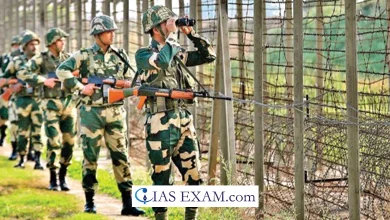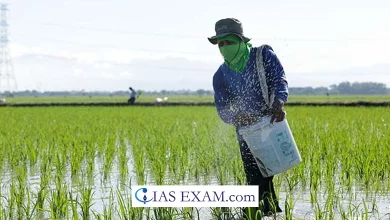Daily Current Affairs for UPSC
Extension of ST status to Gond community

Topic- Polity and Governance [GS Paper-2]
Context- Recently, the Rajya Sabha has passed the Bill to extend ST status to Gond community in four districts of UP
Key Highlights
- The bill aims to move the Gond community from the Scheduled Castes list to Scheduled Tribes list.
- It was passed by the Lok Sabha in April 2022.
Background of the proposed Bill
- The demand for inclusion of the Gond community in the ST list was first raised during the 1980s.
- The Bill requires to amend the Constitution (Scheduled Tribes) (Uttar Pradesh) Order, 1967 (ST Order) and the Constitution (Scheduled Castes) Order, 1950 (SC Order) with respect to its application to Uttar Pradesh.
- It will also ensure the inclusion of the Gond community in the Scheduled Tribes list in four districts of Uttar Pradesh i.e.
- Sant Kabir Nagar
- Sant Ravidas Nagar
- Kushinagar
- Chandauli.
About the Gonds
- Gond refers to tribal peoples who live all over India’s Deccan Peninsula.
- These people most describe themselves as Gonds (hill people) or as Koi or Koitur.
- They mostly live in the states of Madhya Pradesh, Maharashtra, Telangana, Andhra Pradesh, Bihar, and Odisha.
- The majority of them speak unintelligible dialects of Gondi which is an unwritten language of the Dravidian family.
- Persa Pen is the most distinctive feature of Gond religion and like many other tribes, Gonds worship a high god known as Baradeo, whose alternate names are Bhagavan, Sri Shambu Mahadeo, and Persa Pen.
Process of Inclusion
- The process to include tribes in the ST list starts with the recommendation from the respective State governments, which are then sent to the Tribal Affairs Ministry, which reviews and sends them to the Registrar General of India for approval.
- This is followed by the National Commission for Scheduled Tribes’ approval before the list is forwarded to the Cabinet for a final decision.
Way Ahead
- The budget allocation under the Scheduled Tribes Component has been raised from Rs 24,594 crore in 2013-14 to Rs 85,930 crore in 2021-22.
- Also several steps have been taken for the education and economic development of Scheduled Tribes in the country.
- Pradhan Mantri Aadi Adarsh Gram Yojana has been implemented in 35,000 villages till now.
5th Schedule of the Constitution
- In the Article 244(1) of the Constitution; the expression Scheduled Areas means such areas as the President may by order declare to be Scheduled Areas.
- The President may at any time by order direct that the whole or any specified part of a Scheduled Area shall cease to be a Scheduled Area or a part of such an area.
- Increase the area of any Scheduled Area in a State can be held after consultation with the Governor of that State.
- Also it applies on any alteration of the boundaries of a State on the admission into the Union or the establishment of a new State, declare any territory not previously included in any State to be, or to form part of, a Scheduled Area.
- Rescind, in relation to a State of States, any order or orders made under these provisions and in consultation with the Governor of the State concerned, make fresh orders redefining the areas which are to be Scheduled Areas.
Criteria for Declaring Schedule Areas:
- Preponderance of tribal population in the area
- Compactness and reasonable size of the concerned area
- Under-developed nature of the area
- Marked disparity in economic standard of the people.
States having Fifth Schedule Areas
- At present, there are 10 States namely Andhra Pradesh, Chhattisgarh, Gujarat, Himachal Pradesh, Jharkhand, Madhya Pradesh, Maharashtra, Odisha, Rajasthan and Telangana which have Fifth Schedule Areas.
6th Schedule of the Constitution
- The 6th schedule provides for the administration of tribal areas in Assam, Meghalaya, Tripura and Mizoram to safeguard the rights of the tribal population in these states.
- This particular provision is provided under Article 244(2) and Article 275(1) of the Constitution.
- It also seeks to safeguard the rights of the tribal population through the formation of Autonomous District Councils (ADC).
Autonomous District Councils (ADC)
- These councils are bodies representing a district to which the Constitution has given varying degrees of autonomy within the state legislature.
- Provisions have been made for the creation of the Councils and regional councils for the exercise of certain legislative and judicial powers.
- However, the jurisdiction of the council is subject to the jurisdiction of the concerned High Court.
- They are endowed with powers to form courts to hear cases where both parties are members of Scheduled Tribes, and the maximum sentence is less than 5 years in prison.
- They have powers to levy taxes, fees and tolls on buildings, land, animals, vehicles, boats, entry of goods into the area, roads, ferries, bridges, employment and income and general taxes for the maintenance of schools and roads.
- The Acts of Parliament or the State Legislature are not applicable to autonomous districts and autonomous regions or apply with specified modifications and exceptions.
- The Governor is vested with powers regarding the councils and He/she, by public notification may
- Include or exclude a new area.
- Create a new autonomous district.
- Define the boundaries of any autonomous district.
- Increase or decrease the area of an existing autonomous district.
- Alter the name of any autonomous district.





.png)



